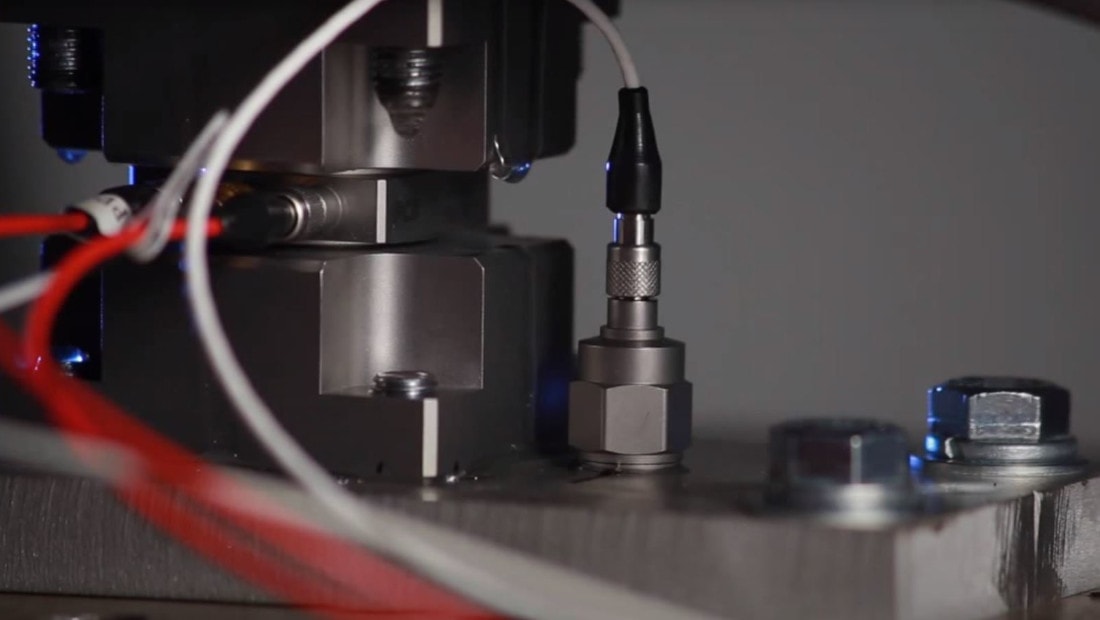To run a conventional vibration test with a shaker system, engineers mount larger structures at one or several fixed attachment points to the shaker. However, the hard mounting of the structure can result in large base reaction forces at its resonances. The conformity of motion at the attachment point(s) is not present in the actual environment, and the mechanical impendence of the shaker can result in over-testing. To prevent such, engineers may set an upper limit with vibration force limiting.
Vibration force limiting prevents over-testing due to these large base reaction forces or other responses at the structure’s fixed-base resonant frequencies. Any vibration test that measures and limits the reaction force at the structure’s base is considered a force limiting test. Force limiting is standard in aerospace testing, although it is appliable to many industries.
Test Setup and Measurement
Engineers often mediate large base reaction forces with force transducers and a vibration control system with response limiting. Force transducers—which contain an electronic strain gauge—react to a force between the structure and the shaker and output an electrical signal proportional to the mechanical force value. With tri-axial transducers, the engineer can measure the three orthogonal directions without adjusting the test setup.

If necessary, the vibration controller then limits the force value based on test specifications. Force limiting is like applying a notch to an accelerometer, except the engineer uses a force transducer. A force limit often results in notching—or reduced input acceleration at the defined frequency range. Force limiting can be applied to any control or measurement channel.
For a demonstration of notching with an accelerometer, please click here.
Vibration Force Limiting in VibrationVIEW
For a Random test in VibrationVIEW, the user can use an equation to limit the drive signal. The software compares the equation to the limit and then adjusts the drive to keep the calculation lower than the limit.
In the case of force limiting, the user can sum the output of several force transducers and notch on the total force applied to the structure. VibrationVIEW defines the limit in the frequency domain and performs notching in the frequency domain.

The notch limit can be a dB level above the demand or a user-defined table. If the limit is above the demand, the software assumes the calculation’s unit is the same as the demand. If the limit is a table, the calculation is assumed to have the same unit as the table.
The high-channel capability of the VR10500 vibration controller is well-suited for vibration force limited testing, as it can require many measurement channels.
Tech Talk: Force Limiting in Sine
In VibrationVIEW’s Sine test mode, you can apply a force limit to one or multiple axes during a sine sweep.
How to Determine Force Limits?
Over-testing can result in weight and performance penalties, which can be great for highly resonant configurations. However, engineers should not use force limiting to compensate for test specifications, and the force and acceleration values should be within reason. The force limit should follow acceleration specifications and normally derive from previous tests.
Why Employ Force Limiting?
Force limiting is a cost-effective method to prevent over-testing associated with hard mounting. Shaker tests tend to be more severe than real-world vibration because only the shaker’s force rating limits the energy.
Vibration force limiting more closely simulates the response of the structure in its field environment. For instance: consider a rocket with a payload mounted to the top. The mounting points from the rocket body to the payload are flexible, and the payload can transfer energy to the body of the rocket. The shaker is heavy and dense and does not deform from the energy imparted onto it. An engineer would use force limiting to limit the total input force at each mounting point to the force experienced in a rocket launch.
Force limiting for sine and random testing is a feature of VibrationVIEW. The software’s demonstration mode is free for all users.
